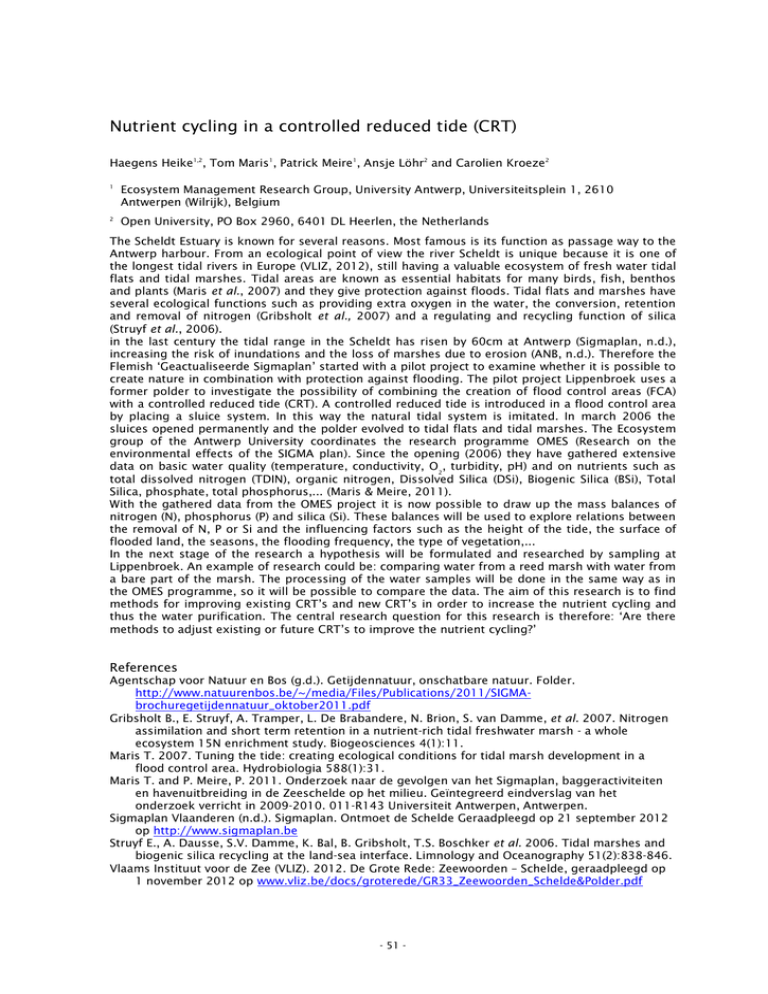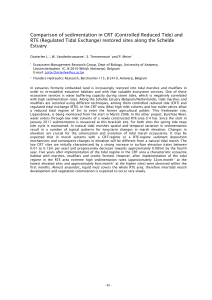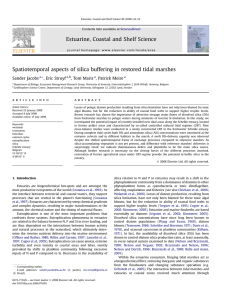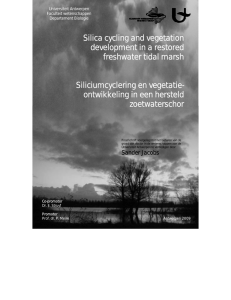Nutrient cycling in a controlled reduced tide (CRT)
advertisement

Nutrient cycling in a controlled reduced tide (CRT) Haegens Heike1,2, Tom Maris1, Patrick Meire1, Ansje Löhr2 and Carolien Kroeze2 1 Ecosystem Management Research Group, University Antwerp, Universiteitsplein 1, 2610 Antwerpen (Wilrijk), Belgium 2 Open University, PO Box 2960, 6401 DL Heerlen, the Netherlands The Scheldt Estuary is known for several reasons. Most famous is its function as passage way to the Antwerp harbour. From an ecological point of view the river Scheldt is unique because it is one of the longest tidal rivers in Europe (VLIZ, 2012), still having a valuable ecosystem of fresh water tidal flats and tidal marshes. Tidal areas are known as essential habitats for many birds, fish, benthos and plants (Maris et al., 2007) and they give protection against floods. Tidal flats and marshes have several ecological functions such as providing extra oxygen in the water, the conversion, retention and removal of nitrogen (Gribsholt et al., 2007) and a regulating and recycling function of silica (Struyf et al., 2006). in the last century the tidal range in the Scheldt has risen by 60cm at Antwerp (Sigmaplan, n.d.), increasing the risk of inundations and the loss of marshes due to erosion (ANB, n.d.). Therefore the Flemish ‘Geactualiseerde Sigmaplan’ started with a pilot project to examine whether it is possible to create nature in combination with protection against flooding. The pilot project Lippenbroek uses a former polder to investigate the possibility of combining the creation of flood control areas (FCA) with a controlled reduced tide (CRT). A controlled reduced tide is introduced in a flood control area by placing a sluice system. In this way the natural tidal system is imitated. In march 2006 the sluices opened permanently and the polder evolved to tidal flats and tidal marshes. The Ecosystem group of the Antwerp University coordinates the research programme OMES (Research on the environmental effects of the SIGMA plan). Since the opening (2006) they have gathered extensive data on basic water quality (temperature, conductivity, O2, turbidity, pH) and on nutrients such as total dissolved nitrogen (TDIN), organic nitrogen, Dissolved Silica (DSi), Biogenic Silica (BSi), Total Silica, phosphate, total phosphorus,... (Maris & Meire, 2011). With the gathered data from the OMES project it is now possible to draw up the mass balances of nitrogen (N), phosphorus (P) and silica (Si). These balances will be used to explore relations between the removal of N, P or Si and the influencing factors such as the height of the tide, the surface of flooded land, the seasons, the flooding frequency, the type of vegetation,... In the next stage of the research a hypothesis will be formulated and researched by sampling at Lippenbroek. An example of research could be: comparing water from a reed marsh with water from a bare part of the marsh. The processing of the water samples will be done in the same way as in the OMES programme, so it will be possible to compare the data. The aim of this research is to find methods for improving existing CRT’s and new CRT’s in order to increase the nutrient cycling and thus the water purification. The central research question for this research is therefore: ‘Are there methods to adjust existing or future CRT’s to improve the nutrient cycling?’ References Agentschap voor Natuur en Bos (g.d.). Getijdennatuur, onschatbare natuur. Folder. http://www.natuurenbos.be/~/media/Files/Publications/2011/SIGMAbrochuregetijdennatuur_oktober2011.pdf Gribsholt B., E. Struyf, A. Tramper, L. De Brabandere, N. Brion, S. van Damme, et al. 2007. Nitrogen assimilation and short term retention in a nutrient-rich tidal freshwater marsh - a whole ecosystem 15N enrichment study. Biogeosciences 4(1):11. Maris T. 2007. Tuning the tide: creating ecological conditions for tidal marsh development in a flood control area. Hydrobiologia 588(1):31. Maris T. and P. Meire, P. 2011. Onderzoek naar de gevolgen van het Sigmaplan, baggeractiviteiten en havenuitbreiding in de Zeeschelde op het milieu. Geïntegreerd eindverslag van het onderzoek verricht in 2009-2010. 011-R143 Universiteit Antwerpen, Antwerpen. Sigmaplan Vlaanderen (n.d.). Sigmaplan. Ontmoet de Schelde Geraadpleegd op 21 september 2012 op http://www.sigmaplan.be Struyf E., A. Dausse, S.V. Damme, K. Bal, B. Gribsholt, T.S. Boschker et al. 2006. Tidal marshes and biogenic silica recycling at the land-sea interface. Limnology and Oceanography 51(2):838-846. Vlaams Instituut voor de Zee (VLIZ). 2012. De Grote Rede: Zeewoorden – Schelde, geraadpleegd op 1 november 2012 op www.vliz.be/docs/groterede/GR33_Zeewoorden_Schelde&Polder.pdf - 51 -






